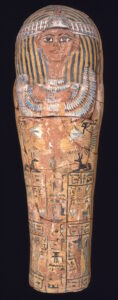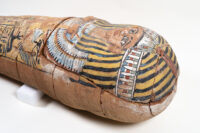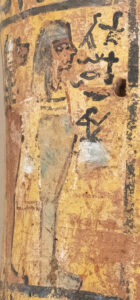
Made of alluvial clay, the sarcophagus dates to the 19th Dynasty (1295–1186 B.C.). It is 43 inches high and vividly painted. The child is depicted wearing a headdress of blue and yellow stripes tied with a headband of white, blue and red lotuses. Lotus petals cover the collar on his chest. The head and chest are on a cut-out section that can be removed to access the interior. Beneath the collar are more lotus flowers, wadjet eyes and the goddess Nut with outstretched wings flanked by Anubis seated jackals. The bottom part of the sarcophagus is covered with hieroglyphs identifying the deceased as a boy named Pa-nefer-neb.


MFA curators initiated an investigation and contacted the Gustavianum to let them know about the discrepancy. Provenance researchers from both museums cooperated and shared information during the process. They found that the sarcophagus went missing from the museum’s stores in 1970 or earlier. It was not deaccessioned or traded. Both parties came to the same conclusion: the coffin had been taken from the Gustavianum illegally and should be returned.
“It is very gratifying that this return has now come to pass. The child’s sarcophagus is an important item in our collections and it means a lot to the museum and the University that it has now been returned to us. The sarcophagus is an excellent complement to our Egyptian collections and will now be available for research,” says Mikael Ahlund, Museum Director of Gustavianum, or Uppsala University Museum. “But the sarcophagus needs some work and it will be some time before it can be shown to the public in Gustavianum,” he adds.
You can see the petite coffin being unpacked upon its return to Sweden in this video.
* This article was originally published here








No comments:
Post a Comment